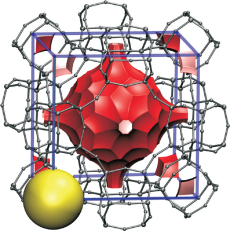Speeding Up Zeolite Evaluation for Carbon Capture

Schematic of an important class of porous materials known as zeolites. The large red structure in the center of this periodic structure is a cavity that might be a good candidate for adsorption of a gas such as carbon dioxide. The seven small red areas at the corners (plus the one hidden by the yellow ball) are not suitable and need to be eliminated from studies that attempt to predict guest-related properties using molecular simulation techniques. A new method developed at NERSC uses software to differentiate between suitable and unsuitable pockets, thereby speeding up discovery of new materials.
Why it Matters: Capturing and sequestering waste carbon dioxide (CO2) is a key means of mitigating the contribution of fossil fuel emissions to global warming but a technological bottleneck involves separation of the CO2 from other gasses. Development of novel materials to efficiently separate and/or absorb CO2 is therefore important. Porous materials such as zeolites are of interest as absorbents but the number of possible zeolite structures has been estimated to be more than 2.5 million and only about 190 structures have been synthesized to date. Simulation methods to identify optimal zeolite structures are needed.
Key Challenges: Although current state-of-the-art molecular simulations allow for accurate prediction of zeolite properties, the characterization of an entire database of hypothetical structures would be out of the question even with today's supercomputers. An important aspect of porous materials analysis is differentiating between legitimate candidate CO2 adsorption pockets and inaccessible void spaces that might be occupied by guest molecules in computer calculations but are actually inaccessible in adsorption experiments. This differentiation is typically done using a manual, time-consuming, visual analysis of individual structures. An algorithmic approach is needed.
Accomplishments: An automatic approach that bypasses manual visual analysis, thereby enabling execution of molecular simulations in an unsupervised, high-throughput manner, has been developed. The approach uses a partial differential equations-based front propagation technique to segment out channels and inaccessible pockets of a periodic unit cell of a material. Elimination of this time-consuming step should facility characterization of large sets of materials required in studies focused on identification of best materials for carbon capture. NERSC resources were critical for the development of the approach, to generate data to test and debug code (which required lots of memory for accurate calculations involving dense grids). After testing was completed, NERSC resources were used to perform initial characterization of 194 zeolites from the database of the International Zeolites Association.
Investigators: Maciej Haranczyk and James A. Sethian (LBNL)
More Information: See J. Chem. Theory Comput. 2010, 6, 3472–3480 (DOI: 10.1021/ct100433z) and the Center for Gas Separations Relevant to Clean Energy Technologies web site.
About NERSC and Berkeley Lab
The National Energy Research Scientific Computing Center (NERSC) is a U.S. Department of Energy Office of Science User Facility that serves as the primary high performance computing center for scientific research sponsored by the Office of Science. Located at Lawrence Berkeley National Laboratory, NERSC serves almost 10,000 scientists at national laboratories and universities researching a wide range of problems in climate, fusion energy, materials science, physics, chemistry, computational biology, and other disciplines. Berkeley Lab is a DOE national laboratory located in Berkeley, California. It conducts unclassified scientific research and is managed by the University of California for the U.S. Department of Energy. »Learn more about computing sciences at Berkeley Lab.







